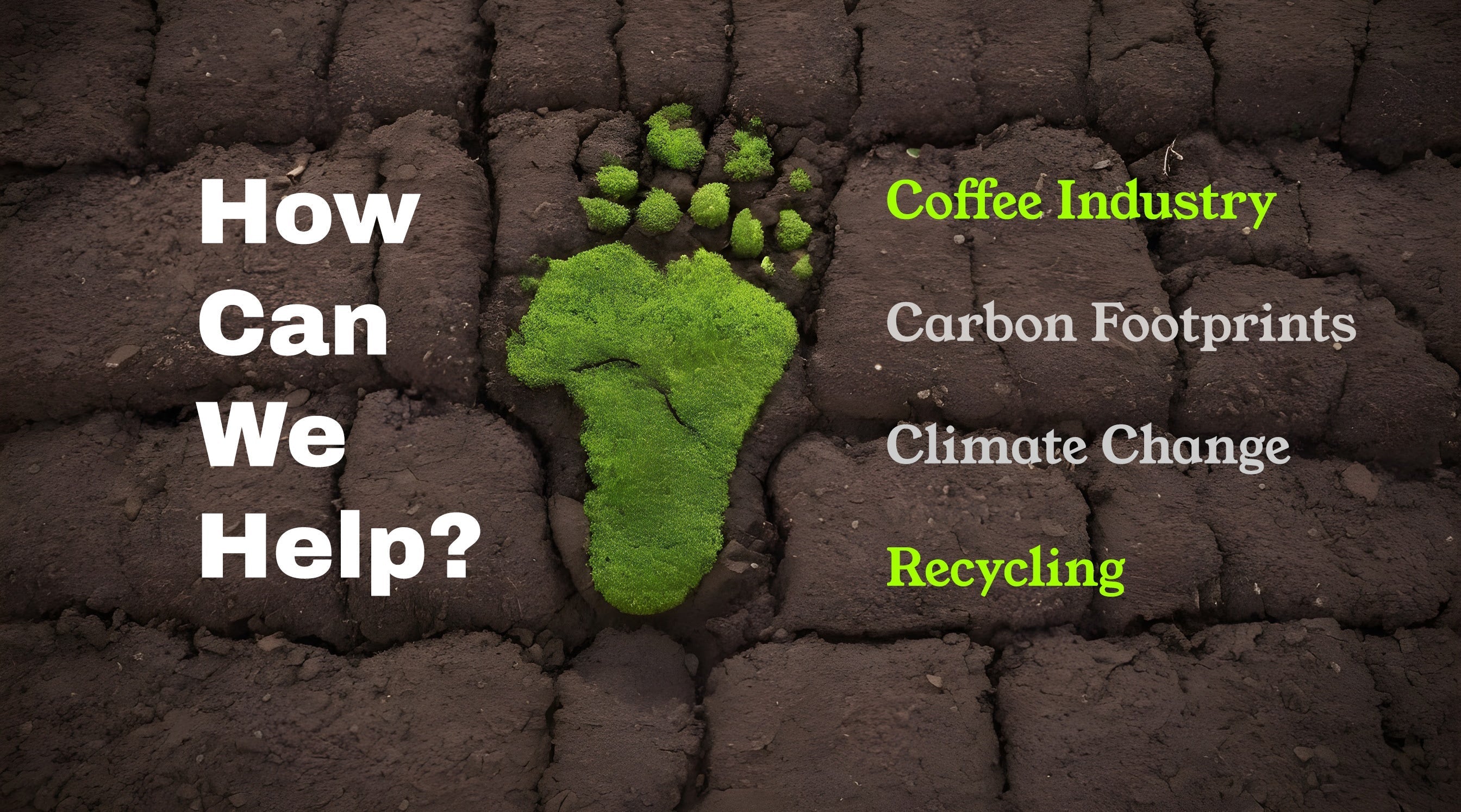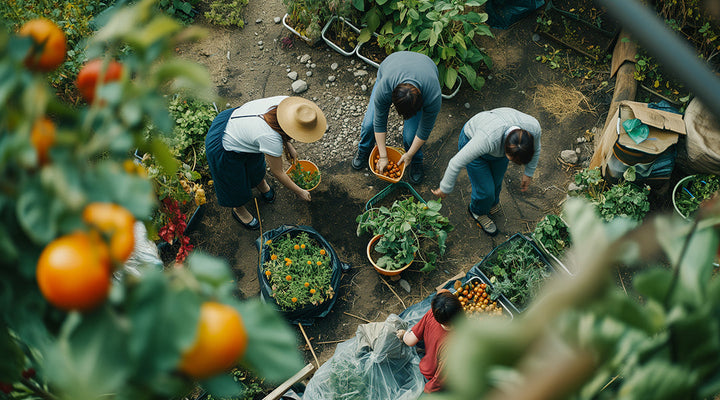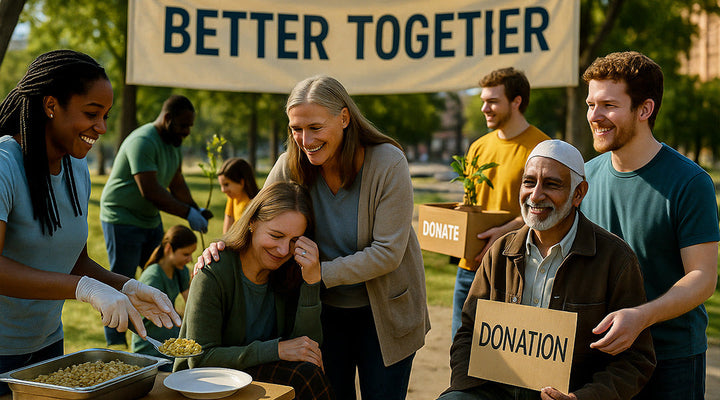
The Coffee Industry, Carbon Footprints, Climate Change, And Recycling - How Can We Help?
Have you ever been in the midst of an overwhelming moment or season of life, and in that moment, someone kindly comes along and asks, “how can I help?”
When I’ve found myself in these situations, I’m grateful for the inquiry, but I have often thought to myself, “they aren’t fully aware of the situation, so how can they truly help?”
In the end, I generally decline the helpful offer, and instead, I’m simply encouraged by the gesture.
Life can be that way at times, even when it comes to producing coffee.
But, unfortunately, a gesture of encouragement doesn’t go far when it comes to coffee production.
You see, the coffee industry has had a massive impact on our environment, and not in a good way.
Simply stated, it’s a problem!
And, blanket concerns in this regard are a good start, but well-meaning intentions of “how can I help” are prone to fall flat without a full understanding of the situation.
So, today we’d like to get a better look at this problem, namely how coffee impacts our planet and what we’re doing here at Lifeboost…to help.
We’ll start with the bad news, giving you a better picture of the problem, followed by the good news, including ways we’re seeking to improve the health of our planet and our customers as we produce clean, sustainably grown coffee.
Then, after we’re all better acquainted with the situation, we’ll conclude with some practical ways you can help as well!
Coffee And The Environment

Farming, including growing coffee, is a needed environmental practice that works with the planet, not against it, right?
In a perfect world, perhaps this would be correct, but alas we do not live in a perfect world.
To say coffee is a popular beverage would be a gross understatement. And, this massive demand has dictated how conventional coffee companies produce their products.
To grow coffee in such large quantities, acre after acre of precious forest lands (oftentimes rainforests) are cleared so hybrid, sun-thriving coffee plants can be grown to meet this demand.
In fact, it is estimated for every cup of coffee produced, one square inch of rainforest is destroyed due to these practices.
This alone robs animals of their natural habitats, potentially changing the needs and nature of such areas for years to come.
Then, as harsh chemicals are used to deter pests, accelerate growth, and mitigate common plant diseases, the soil and surrounding waterways, plants, and animal life are also greatly harmed.
Yes, deforestation, polluted air, soil, and waterways, climate change, and disrupted ecosystems are all byproducts of conventionally grown coffee.
One study done by a research institute in Finland found that coffee farming and processing makes up for 68% of coffee’s impact on climate change.
And, if that wasn’t enough, in the name of convenience our society has also demanded faster, more simplified ways to enjoy java, prompting the creation and use of pods, capsules, and k-cups, each of which are small but combine enmasse in landfills across the globe.
Nearly ten years ago, scientists estimated that the number of coffee pods (including all varieties) in landfills, lined end to end, could circle the globe 10-12 times.
And folks, let’s face it, we all know that a love for both convenience and coffee has increased exponentially in the last 10 years.
Experts even believe the popularity of coffee will continue to increase, with expectations of production goals expanding threefold by the year 2050.
So then, imagine our world 25 years from now should coffee production continue down this planet-plundering path?
It sounds like we all need to give up coffee in order to preserve our planet then, right?
Wrong!
Thankfully, there’s a better solution!
How Can We Help?

Truthfully, we could’ve gone into more detail above, you know, regarding the bad news.
But frankly, there’s enough bad news and negativity in this world, so we’d like to focus on some good news.
Thankfully, many coffee companies have recognized the impact that growing their product has on our planet.
Like Lifeboost, many companies continually strive to improve packaging to make these items more environmentally friendly.
Then, did you know recycled coffee cups are now being used as home building materials?
And, old coffee beans have been used to make furniture, jewelry, etc., while used coffee grounds are now being repurposed for use in facial scrubs, gardening aids, and soap.
Even greater, like Lifeboost, some companies are also choosing to consider the environment in their coffee growing practices.
But, since we can only speak confidently and accurately of our own methods and efforts, let’s focus on those for a moment.
Many of you may be familiar with sustainable farming, but we’d like to detail our practices for you here, so we can all get a better look at how these efforts help the earth, rather than hinder it.
First, we absolutely will not contribute to the deforestation of our planet. This is of monumental importance to us here at Lifeboost.
So, all Lifeboost coffee is grown on small, family run farms.
And, instead of removing plant life (aka deforestation) to grow our coffee, our plants use and are used in the growing process.
It’s a type of symbiotic relationship if you will, one where our coffee shrubs fit perfectly into an already thriving ecosystem.
For example, our coffee shrubs use the shade of native plants for protection against the harsh sun and animal predators.
Then, our coffee shrubs are used to provide shade and a habitat for plants and animals underneath.
Our coffee plants use the decomposing leaves nearby to gain nutrients from the soil.
And, our coffee plants are also used to provide equal benefits to the other fauna in the same way.

Instead of clearing forest vegetation to grow our coffee, robbing native animal and insect life of habitat and home, our coffee shrubs are used to shelter small animals and attract other species to the area to feed on those insects which typically feed on coffee shrubs.
Lifeboost coffee shrubs also benefit from pollinators in the area, which is, of course, a mutually beneficial relationship as well.
Aside from this, nearly all of our coffee is grown in regions protected by the Rainforest Trust.
The Rainforest Trust, to date, has protected 45.7 million acres of land across the globe, and by growing our coffee in some of these regions, this ensures all growing practices are 100% environmentally friendly.
In many of these protected regions, the Rainforest Trust also works with farming families, supporting the people behind the agricultural communities in these areas.
The planet-preserving work of the Rainforest Trust across the globe is a cause we fully believe in, and this is why we also, proudly, support the Trust financially.
Then, did you also notice anything lacking in the above described growing methods?
No chemicals!
Lifeboost coffee is always grown without the use of harsh chemicals such as pesticides, fertilizers, herbicides, etc.
That’s right…nothing….nada…none.
And, why would we ever need to use such health and habitat harming chemicals in the first place?
The use of pesticides on coffee plants not only pollutes the air, soil, and surrounding waterways, this also remains on the coffee cherries to later harm the health of consumers.
The same is true of fertilizers, herbicides, fungicides, and more.
These chemicals wreak havoc on plant and animal life, they decrease biodiversity, destroy ecosystems, and greatly hinder the health of our bodies when we consume items treated with them.
Then, another major impact on carbon emissions, when it comes to growing coffee, is water usage, and this is just one more proof in what I’d like to call the natural pudding.
By growing our coffee at high elevations in protected regions of rainforest mountains, our shrubs benefit from falling rainwater, which nourishes our plants prior to trickling down the mountain.
This natural effect prevents the use of water-wasting irrigation systems as well as the accumulation of moisture and mold on our coffee cherries.

But, we also recognize that despite all of these efforts and practices to preserve our planet, producing coffee still impacts our climate, our planet, and our future.
Yes, even when you check all of the sustainability boxes, there’s still a price to pay for utilizing the earth.
And, that’s why we’ve partnered with EcoCart.
Producing and shipping our coffee leaves a footprint, and this mark is just another part of how the coffee industry is negatively affecting our planet.
Partnering with EcoCart is just one way we offset this impact, and we’re proud to say, to date, that Lifeboost coffee is carbon neutral, having offset our carbon emissions to the tune of 120 tons of CO2.
And, before we move on to ways you can do your part as well, let’s address the tiny elephant in the room.
Remember the tiny landfill remnants we mentioned earlier, those coffee conveniences being tossed into trash mines in quantities exceeding 10 billion parts per year, aka coffee pods?
Our customers asked for them, and we greatly desired to deliver on that request.
But, we couldn’t contribute to this crisis in good faith, so we created a completely recyclable coffee pod, one which conveniently delivers our beloved, tasty, decadent Lifeboost coffee, in pod form, without the dread of these cups piling up in landfills.
So, all Lifeboost coffee pods are made from beverage safe plastics which are completely recyclable.
Each of these practices listed above allow us to grow, process, roast, and deliver clean, healthy coffee to you, our customers, but what’s equally important, is that each of these practices also allow us to grow Lifeboost coffee in a way that helps our planet.
From improving biodiversity and soil quality to protecting our rainforests, offsetting our carbon footprint, and producing recyclable options, we’re continually seeking ways to get better, be better, and do better for the environment and our world as a whole.
But, now that we’ve gotten a better look at the situation, including ways we’re seeking to help here at Lifeboost…what about you?
If you’re reading this article, it’s likely that you’re interested in helping our world as well, so let’s close out our time here today with some practical ways you can do just that!
How Can You Help?

When it comes to enjoying coffee and preserving our planet, we have a few tips to keep in mind.
This may seem a little self-serving here, but I’m confident in our heart and plan for coffee production, one that keeps planetary and bodily health in mind, so first…drink Lifeboost coffee.
As I mentioned earlier, I can’t speak to the practices of other companies, but I can assure you that Lifeboost coffee is chemical free (it’s even 3rd party tested to confirm this), our pods are recyclable, our growing methods are fully sustainable, and we are carbon neutral!
We have four pillars which define and drive our practices here at Lifeboost - Clean, Cause, Connection, and Kindness.
And, as for our cause pillar, we believe in supporting causes near and dear to our heart, and protecting and preserving our planet is one thing we’re passionate about.
This is why we go the extra mile, impart the extra measures, and opt for offering extra support to those charities, agencies, and organizations which seek to support a healthy earth.
When you choose Lifeboost coffee, you are saying no to deforestation, no to the destruction of ecosystems, and yes to a healthy planet.
But, you can take this a step further when you choose to recycle.
Between 2020 and 2050, it is estimated that recycling will reduce emissions by 5.5 to 6.02 gigatons of carbon dioxide.
Recycling is one of the most practical and easy ways we can all, each and every one of us, help to curb greenhouse gas emissions.
And, when it comes to coffee drinkers, we have a lot to potentially contribute here!
Coffee accounts for 23 million tons of garbage annually.
So, it’s imperative that we each make the choice to recycle, even when it comes to coffee.
Not sure how to do this? Just take a look…
First, simply recycle your used Lifeboost coffee pods.
And, consider brewing with a reusable filter to reduce overall waste and customize your cup to your personal preference.
Then, repurpose or reuse your used coffee grounds.
Did you know, if your need is big enough, you can even ask for used coffee grounds at local cafes in an effort to reduce waste?
- Used coffee grounds are great ways to boost the health of your garden as they contain key minerals needed by plants for healthy growth.
Using coffee grounds in your garden soil is also said to attract worms, a garden’s best friend.
To use coffee grounds in your garden as a natural fertilizer, simply sprinkle them on the soil surrounding your plants.
As a bonus, many report the use of coffee grounds also deters many insects and other pests!
- Used coffee grounds are also great for composting. So, if you don’t have an immediate need for your used grounds, sprinkle them on your compost heap. This will provide the nutrients and minerals you’re seeking in your compost pile which you can later use as needed.
- As we mentioned above, used coffee grounds may also repel unwanted insects such as mosquitoes. You can place used grounds in open containers in areas you frequently enjoy being outdoors to keep pests away.
- Place used coffee grounds in your refrigerator, freezer, or any area where you wish to absorb or neutralize odors.
- Many have recognized the harm cleaning chemicals can cause to physical health as well as the environment, so when you’re seeking alternative cleaning solutions, consider the abrasive nature of used coffee grounds as a cleaning agent.
Cleaning your grill, scouring your sink…well, really using them on anything nonporous, can be made simple with the use of coffee grounds (again, used and rinsed grounds).
- The abrasive texture of used coffee grounds is also beneficial to your skin as they act as a natural exfoliant.
- Mix used grounds with a small amount of water or coconut oil and gently apply to your skin to help remove dirt and/or dead skin cells to clean and refresh your skin (face and body).
- And, as a bonus, the caffeine content of the used grounds has been known to effectively increase blood flow and protect the skin from sun damage when used regularly.
- You can forgo the use of chemical dyes as well when using used coffee grounds to dye fabrics, paper, linen, cotton, etc. Simply rewet the grounds prior to use. (This can even be done to slightly darken brown hair.)
- And, you can even use coffee grounds to tenderize meat as coffee contains acids which work to both tenderize and enhance the flavor of meat.
Then, I’m sure this goes without saying, but when possible, seek to avoid disposable coffee mugs and cups as well.
I know, I know, many disposable coffee cups can be recycled, and certainly, if you’re using these, please recycle them. But, when you can, opt for a reusable hot or cold coffee cup.
Personally, I’m a sucker for a good thermal to-go mug or a cold brew companion. Trust me when I say, these can be used over, and over, and over again…all day, all the time.
And, when it comes to ceramic coffee mugs, if you’re looking to recycle or repurpose these, consider using old mugs to make mosaics, double their use as soup cups, pen and pencil holders, or even use an old or semi-broken mug as a decorative bird feeder.
From coffee growth and production, shipping, sipping, and more, there’s always a way to (and let me add on this familiar saying) reimagine, reduce, reuse, and/or recycle.
When we reimagine conventional growing methods, we incorporate practices that help (not hinder) the environment.
And, when we reduce waste through reusing and/or recycling coffee cups, mugs, packaging, and grounds, we’re also incorporating practices that…help.
Check out Lifeboost Coffee Embolden Dark Roast.

Becky is a mother, educator, and content writer for Lifeboost Coffee. She has had three years’ experience as a writer, and in that time she has enjoyed creatively composing articles and ebooks covering the topics of coffee, health and fitness, education, recipes, and relationships.
- https://www.theworldcounts.com/challenges/consumption/foods-and-beverages/environmental-effects-of-coffee-production
- https://coffeegreenbeans.com/blogs/producers/what-effects-does-coffee-have-on-the-environment-and-how-does-it-mitigate-them
- https://sanjoserecycles.org/guide/coffee-capsules/
- https://tracextech.com/coffee-carbon-footprint-in-supply-chain/
- https://www.sjwater.com/our-company/news-media/water-blogged/avoid-water-waste-proper-irrigation-and-maintenance
- https://www.rainforesttrust.org/
- https://thegreatcoffeeproject.com/blogs/inside-the-great-coffee-project/how-the-coffee-industry-is-recycling-and-reusing-to-save-the-planet
- https://www.colorado.edu/ecenter/2023/12/15/impact-recycling-climate-change
- https://www.healthline.com/nutrition/uses-for-coffee-grounds
- https://muselot.in/blogs/news/15-tips-to-repurpose-broken-coffee-mugs
- References for the article to confirm data and information.










